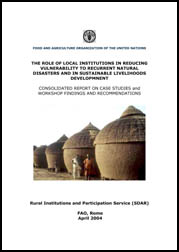
THE ROLE OF LOCAL INSTITUTIONS
IN REDUCING VULNERABILITY TO RECURRENT NATURAL DISASTERS AND IN SUSTAINABLE
LIVELIHOODS DEVELOPMENT
CONSOLIDATED REPORT ON CASE STUDIES AND WORKSHOP FINDINGS AND RECOMMENDATIONS
Prepared by:
Federica Battista and Stephan Baas
Rural Institutions and Participation Service, FAO
FOOD AND AGRICULTURE ORGANIZATION OF THE UNITED NATIONS
Rural Institutions and Participation Service (SDAR)
FAO, Rome
April 2004